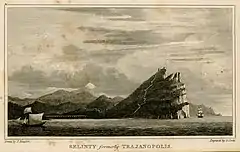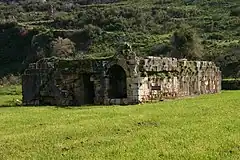Selinus (Cilicia)
Selinus or Selinous (Ancient Greek: Σελινοῦς) was a port-town on the west coast of ancient Cilicia and later of Isauria, at the mouth of a small river of the same name, now called Musa Çay.[1][2][3][4][5] It is located west of the modern city of Gazipaşa in Turkey.[6][7]
.jpg.webp)
History
Selinus is memorable in history as the place in which Emperor Trajan is said by some authors to have died in 117 AD.[8] After that event, the place for a time bore the name of Trajanopolis or Traianopolis (Τραϊανούπολις), but its bishops afterwards are called bishops of Selinus.[9] Basil of Seleucia describes the place as reduced to a state of insignificance in his time[10] though it had once been a great commercial town.[11]
The site
Selinus was situated on a precipitous rock, surrounded on almost every side by the sea, by which position it was rendered almost impregnable. The whole of the rock, however, was not included in the ancient line of fortifications. Inside the walls there still are many traces of houses, but on the outside and between the foot of the hill and the river, the remains of some large buildings are yet standing, which appear to be a mausoleum, an agora, a theatre, an aqueduct and some tombs. No longer a residential bishopric, it remains a titular see of the Roman Catholic Church.[12]
 Trajanopolis from Beaufort (1817)[13]
Trajanopolis from Beaufort (1817)[13] Trajan's Mausoleum
Trajan's Mausoleum.jpg.webp) Aqueduct
Aqueduct
References
- Richard Talbert, ed. (2000). Barrington Atlas of the Greek and Roman World. Princeton University Press. p. 66, and directory notes accompanying.
- Periplus of Pseudo-Scylax; Livy. Ab urbe condita Libri [History of Rome]. Vol. 33.20.
- Strabo. Geographica. Vol. xiv. p. 682. Page numbers refer to those of Isaac Casaubon's edition.
- Ptolemy. The Geography. Vol. 5.8.2, 8.17.42.
- Pliny. Naturalis Historia. Vol. 5.22.
- Richard Talbert, ed. (2000). Barrington Atlas of the Greek and Roman World. Princeton University Press. p. 66, and directory notes accompanying.
- Lund University. Digital Atlas of the Roman Empire.
- Cassius Dio. Historia Romana (Roman History). Vol. 68.33.
- Hierocles. Synecdemus. Vol. p. 709.
- Basil of Seleucia, Vita S. Theclae, 2.17.
- Stadiasmus Maris Magni §§ 203, 204; Lucan 8.260; Chron. Paschale, p. 253.
- Catholic Hierarchy
- Beaufort, Francis (1817). Karamania, Or A Brief Description Of The South Coast Of Asia Minor. London: R. Hunter.
![]() This article incorporates text from a publication now in the public domain: Smith, William, ed. (1854–1857). "Selinus". Dictionary of Greek and Roman Geography. London: John Murray.
This article incorporates text from a publication now in the public domain: Smith, William, ed. (1854–1857). "Selinus". Dictionary of Greek and Roman Geography. London: John Murray.